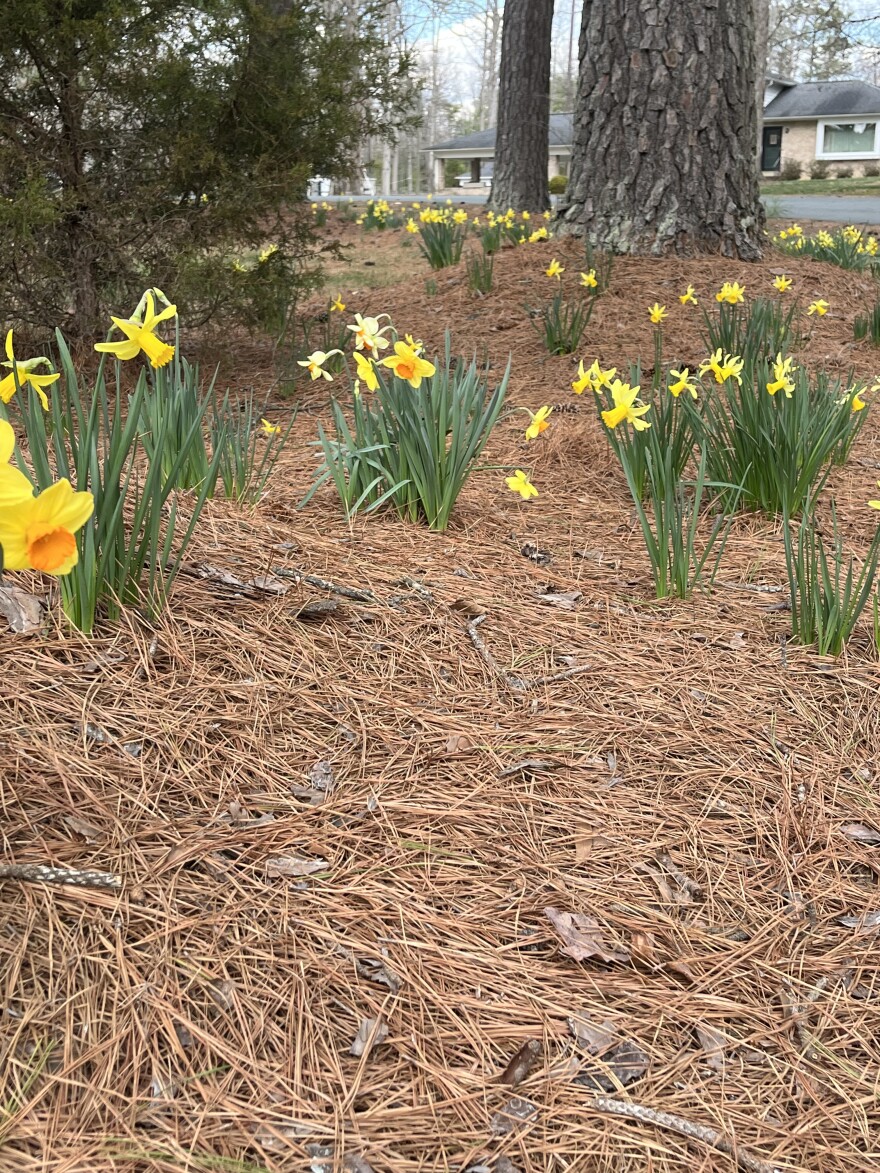With windowsills and artificial growing systems full of seedling trays keeping my thoughts on the young plants growing inside, I remind myself to enjoy the landscape unfolding outside.
February is a magical month during which plants begin to emerge from their winter dormancy. One of the first are the red maple trees, Acer rubrum, which bloom and set seeds before their leaves emerge. Native to the East Coast, the soft red hues of these wind pollinated flowers infuses color into the winter landscape. Next, the blossoms and small dangling seed pods of the American elm trees, Ulmus americana, add a light green to the soft reds of the maples in the brown woodlands.
In the shrub layer of the landscape the change is more visible. Vernal witchhazel, Hamamelis vernalis, is native to Virginia and usually begins blooming in January. The shrub’s tall arching branches display fragrant, yellow and red to orange flowers. The delicate flowers look like small tufts of threads along the branches. This is similar to the red berry-covered branches of winterberry holly, Ilex verticillata. This native deciduous holly holds its berries through the winter creating quite a display until the birds and small mammals feast upon them.

Still, come February I am anxious for color in the garden and the flowers of the minor bulbs and other non-native plants fill the void with their vibrant colors. One of the first to bloom are snowdrops, Galanthus nivalis. The bright white nodding flowers rise above the clusters of green leaves, even in the snow.
In shaded areas the delicate soft pink flowers of Eastern cyclamen, Cyclamen coum, bloom above the silver variegated leaves. Conversely, the variety of flower colors of crocus blossoms brighten the winter garden with yellows, whites, lavenders and purples. To thwart hungry squirrels, consider planting the colorful varieties of Crocus tommasinianus – the ‘Ruby Giant’ variety is a favorite of mine.
An early blooming plant I encourage you not to grow is winter aconite. The low growing, yellow blooming Eranthis hyemalis spreads quickly by seed becoming a nuisance in your garden and other gardens nearby.
Nothing brightens a gray day like daffodils – and yes, there are daffodils that bloom in January and February. The first of the trumpet flower type Narcissus to bloom is N. ‘Rijnveld’s Early Sensation’. Close behind is the aptly named daffodil, N. ‘February Gold’, which is smaller in height but just as bright and cheerful.

I enjoy growing larger exotic plants which light up the winter landscape and one of my favorites is winter jasmine, Jasminum nudiflorum. The bright yellow star-shaped flowers are often confused with the yellow blossoms of forsythia, which blooms later in the spring. The branches of this low arching shrub are green, creating an evergreen appearance even when the leaves are not present.
Another favorite of mine is winter Daphne, Daphne odora ‘Variegata’. This shade-loving shrub blooms for weeks from mid-February well into March. The pink or white flowers are extremely fragrant, and the plant itself is lovely all year round.
Who doesn’t like Camellia japonica? The bold flowers of the myriad of varieties bloom from fall to mid-March. When choosing a camellia variety for your garden remember to check the plant tag for the bloom period and plant height for proper placement.
A lesser-known plant is winter-flowering heather, Erica carnea. This low growing, bright pink to purple blooming evergreen thrives in well drained acidic to neutral soil. However, if you garden in heavy clay soil it’s best to grow heather in a container.

I finish this list with the shade loving, always reliable, hellebores. Helleborus niger, the Christmas rose, has pure white saucer shaped “flowers,” or calyx, which typically start to bloom in late December or early January. Conversely, the multicolored “flower” colors of Helleborus x hybridus always catch my eye with colors ranging from white, cream, pink, purple to green and even soft yellow. The plants are larger and more vigorous than H. niger and are easy to find at your local garden center.
When adding non-native plants to your site please be aware of the important role local native plants play in the environment. Local native plants are a key component of a sustainable ecosystem. Research findings show 60-70% of the mass of plants on a property should be native, and that it is fine to grow a few non-native, non-invasive plants as well. Planting some of these late winter flowering plants together with local native plants will not only brighten the February garden, but in many cases, add fragrance as well.
Happy Gardening!
Peggy







